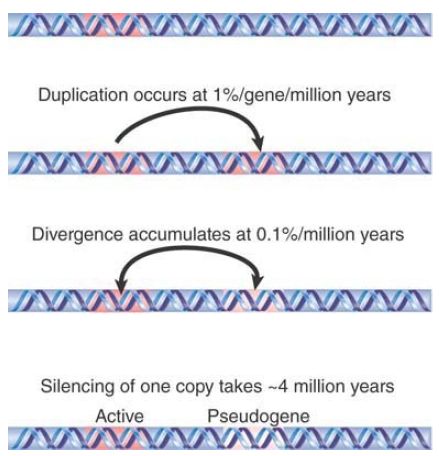
Gene Duplication Contributes to Genome Evolution
 المؤلف:
JOCELYN E. KREBS, ELLIOTT S. GOLDSTEIN and STEPHEN T. KILPATRICK
المؤلف:
JOCELYN E. KREBS, ELLIOTT S. GOLDSTEIN and STEPHEN T. KILPATRICK
 المصدر:
LEWIN’S GENES XII
المصدر:
LEWIN’S GENES XII
 الجزء والصفحة:
الجزء والصفحة:
 16-3-2021
16-3-2021
 2168
2168
Gene Duplication Contributes to Genome Evolution
KEY CONCEPT
-Duplicated genes can diverge to generate different genes, or one copy might become an inactive pseudogene.
Exons act as modules for building genes that are tried out in the course of evolution in various combinations . At one extreme, an individual exon from one gene might be copied and used in another gene. At the other extreme, an entire gene, including both exons and introns, might be duplicated. In such a case, mutations can accumulate in one copy without elimination by natural selection as long as the other copy is under selection to remain functional. The selectively neutral copy might then evolve to a new function, become expressed at a different time or in a different cell type from the first copy, or become a nonfunctional pseudogene.
FIGURE 1. summarizes the present view of the rates at which these processes occur. There is about a 1% probability that a particular gene will be included in a duplication in a period of 1 million years. After the gene has duplicated, differences evolve as the result of the occurrence of different mutations in each copy. These accumulate at a rate of about 0.1% per million years.

FIGURE 1. After a globin gene has been duplicated, differences can accumulate between the copies. The genes can acquire different functions or one of the copies may become a nonfunctional pseudogene.
Unless the gene encodes a product that is required in high concentration in the cell, the organism is not likely to need to retain two identical copies of the gene. As differences evolve between the duplicated genes, one of two types of event is likely to occur:
- Both of the gene copies remain necessary. This can happen either because the differences between them generate proteins with different functions, or because they are expressed specifically at different times or in different cell types.
- If this does not happen, one of the genes is likely to become a pseudogene because it will by chance gain a deleterious mutation and there will be no purifying selection to eliminate this copy, so by genetic drift the mutant version might increase in frequency and fix in the species. Typically, this takes about 4 million years for globin genes; in general, the time to fixation of a neutral mutant depends on the generation time and the effective population size, with genetic drift being a stronger force in smaller populations. In such a situation, it is purely a matter of chance which of the two copies becomes nonfunctional. (This can contribute to incompatibility between different individuals, and ultimately to speciation, if different copies become nonfunctional in different populations.)
Analysis of the human genome sequence shows that about 5% of the genome comprises duplications of identifiable segments ranging in length from 10 to 300 kb. These duplications have arisen relatively recently; that is, there has not been sufficient time for divergence between them for their homology to become obscured.
They include a proportional share (about 6%) of the expressed exons, which shows that the duplications are occurring more or less without regard to genetic content. The genes in these
duplications might be especially interesting because of the implication that they have evolved recently and therefore could be important for recent evolutionary developments (such as the separation of the human lineage from that of other primates).
 الاكثر قراءة في مواضيع عامة في الاحياء الجزيئي
الاكثر قراءة في مواضيع عامة في الاحياء الجزيئي
 اخر الاخبار
اخر الاخبار
اخبار العتبة العباسية المقدسة


